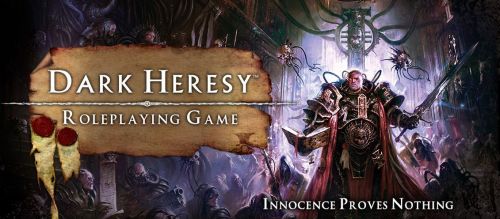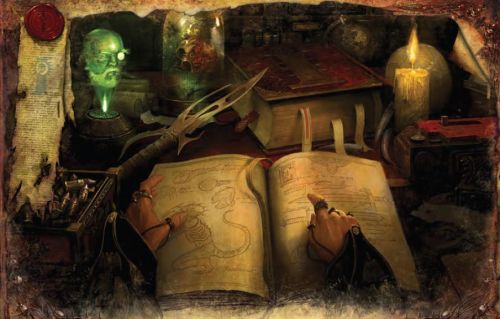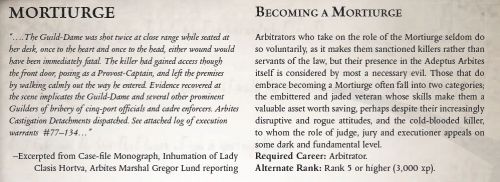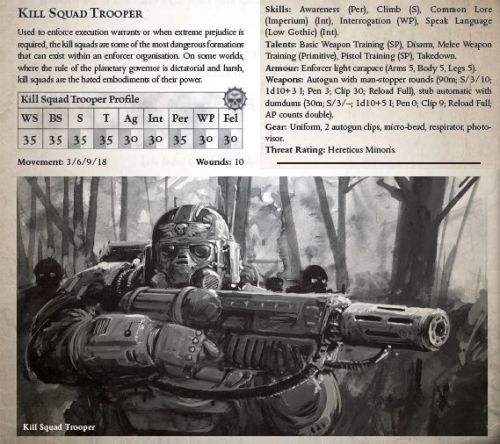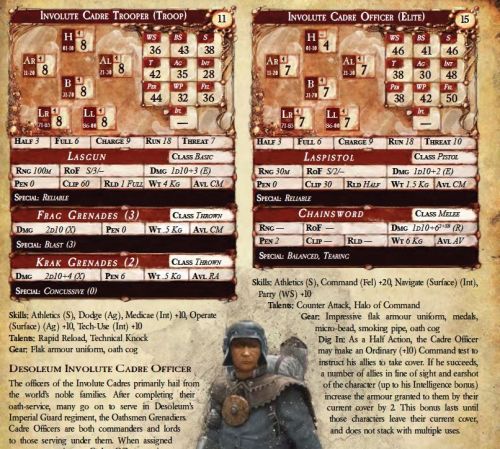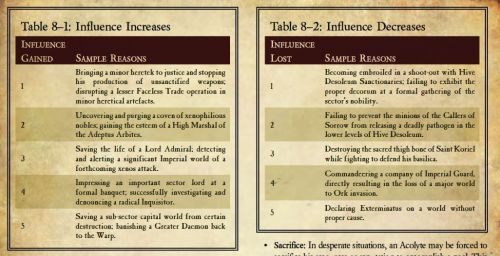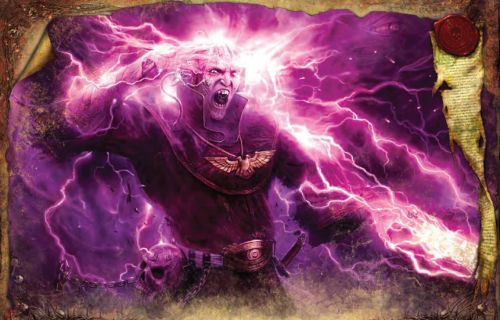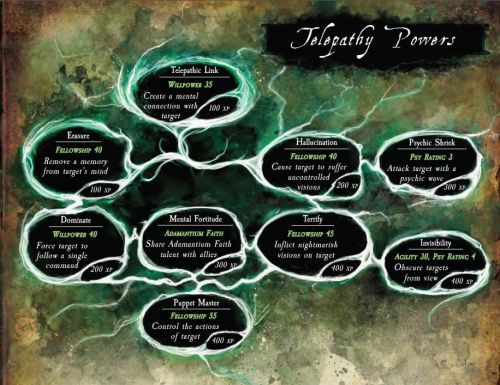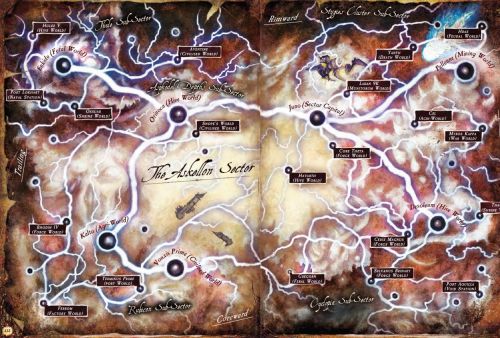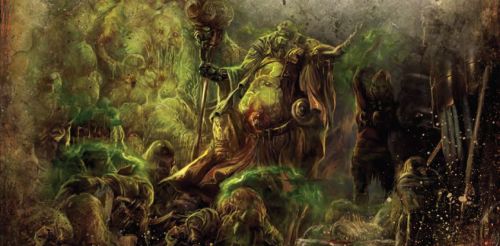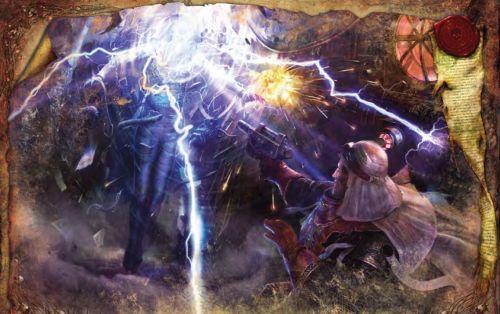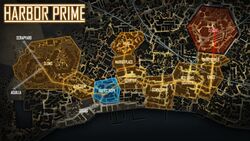RPG Codex Review: WH40k - Dark Heresy, 2nd Edition
RPG Codex Review: WH40k - Dark Heresy, 2nd Edition
Review - posted by Grunker on Mon 10 November 2014, 10:35:16
Tags: Dark Heresy; Fantasy Flight Games; Games Workshop; WH40kReview by Darth Roxor
Edited by Grunker
RPG Codex doesn’t get nearly enough pen-and-paper-related content, so I decided to sit down and rectify that. And what better topic would there be to write about than the recently released second edition of Dark Heresy?
Honestly, probably a whole lot of them. However, Dark Heresy is a fairly popular system, mostly because of two key aspects – its pulpy Warhammer 40k setting, and its core mechanics, which were originally heavily rooted in the Warhammer Fantasy Roleplay's second edition. Dark Heresy and its offshoots are also probably the PnP RPGs that I’ve played the most, both as a player and a gamemaster, although much more often in the second role. It goes without saying that it means something special to me.
The original Dark Heresy was created in 2008 by Black Industries, and over the years, the amount of supplements, sister systems (like Rogue Trader, Deathwatch, Black Crusade and Only War) and supplements to said sister systems literally piled up in dozens. Just about all of these were created by Fantasy Flight Games, which took over the rights to Dark Heresy and the 40k roleplaying system shortly after its publication. Some of those came out better, some came out worse, many were completely insane and downright badly designed or thought through, but that is not the topic of this article. The topic is the second edition of Dark Heresy, and the main questions are threefold:
- Whether it managed to fix some of the original’s glaring flaws
- Whether the overall theme of roleplaying an inquisitor’s private retinue of investigators tracking down WITCHCRAFT, HERESY AND MUTATION was preserved.
- Whether Fantasy Flight Games managed to cherry pick some of the better additions from the previous supplements and offshoots.
I will thus try to analyse the game mostly in relation to its predecessor. Since I assume many of you are not familiar with Dark Heresy, this will require some slightly detailed delving into the old system’s mechanics where necessary.
As a final addendum to this already long introduction, I would like to thank all the prestigious community members who had a hand in the creation of this review.
Most credit goes to Jaedar, who agreed to take up the mantle of the GM and lead us through the trainwreck that is this system’s starting adventure. Most importantly, he did that by painstakingly clinging to every little ridiculous detail included in the adventure, which won him a lot of hate from his players, but ultimately allowed us to better understand Fantasy Flight Games’ insanity.
Credit also goes to the players that participated in the experiment - desocupado, herostratus, root, Reject_666_6 and Excidium.
NOTE: from now on I’ll refer to Fantasy Flight Games as ‘FFG’, to the original Dark Heresy as ‘DH1’ and to the second edition as ‘DH2’.
The Genesis
DH2 was already in dire straits very early on when the first beta edition was sent to the testers. It has to be said that FFG started off very ambitiously, and the first beta’s mechanics were actually completely different from DH1. Many of the changes were obviously made in order to address some of the original’s biggest issues, namely the low starting power of the player characters, the burst fire rules, the broken damage reduction mechanics, and the “accurate” weapon quality.
The PCs were now more powerful out of the box – they started with more skills and fate points, experience costs to improve statistics were mostly lower, and skills were more like ‘groups’ with ‘subskills’, which meant that a character getting 1 skill effectively got 3. It also changed some of the ridiculous rules like Intimidate always being rolled against Strength – now it was divided into Coerce (Willpower) and Threaten (Strength), making it useful for more than just one character archetype.
However, many of the additions were not very well designed. For starters, in DH1, what primarily defined your character and gave you career advancement tables for spending XP was your background – techpriests, imperial guardsmen, scum, psykers, etc. The DH2 beta coupled backgrounds (raw starting stats and skills) with “player roles” that gave one role-specific talent, and the xp spending tables. The problems here stemmed mostly from very poor naming conventions and connections (you could, for example, roll a Techpriest Desperado or a Guardsman Sage) and from the fact that the game didn’t really recognise your background from now on mechanically. You started as a techpriest? In the eyes of the game you were identical to the outcast and the arbitrator. This simply made characters more generic, and much less thematic, which is an enormous flaw in a game system driven mostly by its background fluff.
The second Very Bad Idea included in the beta was the new talents – DH1 had quite an impressive list of cool talents - a list that kept getting butchered across all the new sister systems - and ultimately, the DH2 beta became the logical conclusion to this butchering. Many of them were simply ‘use a fate point to succeed automatically and make something awesome happen!’ (more on that later). This is plainly half-arsed, since fate points in Dark Heresy usually serve as rerolls anyway. To add insult to injury, they were grouped in ‘talent trees’ that were very badly crafted – to get *anything* worthwhile, you had to buy a whole load of stuff you’d never use.
However, the most significant changes were made to the game's combat mechanics, and it was here that the beta started turning really ugly.
To begin with, DH1’s hit point system was ditched in favour of wound tables. If you got damaged, you rolled for a wound effect on an appropriate table instead of just slashing off HP. Certainly a noble endeavour, but one that becomes much less appealing when you realise there are 9 pages of tables in total, accounting for every damage type and hit location possible. Can you imagine just how much unnecessary book-keeping that entails, and how it bogs down the system’s already slow combat?
Secondly, the way combat worked was nearly entirely different because of the addition of actions points. In DH1, characters had only 2 standard actions available to them per turn (as well as a single reaction each turn and the option of chaining 2 standard actions into a single, full action). This mostly changed how weapons worked, because now each weapon had an ‘ap cost to fire’. So for example, a rocket launcher cost 3 AP to fire, while a machine gun could shoot 3 times per AP. I suspect this mostly served to address the problem of burst fire in the 40k roleplaying system, which has been the subject of much debate ever since DH1 came into existence.
In DH1, shooting on full auto granted you a +20 to your hit chance, and made the target take an additional hit per degree of success (every 10 on the roll below your Ballistic Skill is 'a degree of success', i.e. rolling 20 with Ballistic Skill 50 = 3 DoS). This was largely considered insanely overpowered, causing spray’n’pray to rule the world. However, most of the offshoots after DH1 changed autofire to grant -10 to BS, which instead made it a complete waste of bullets unless you had very high BS (which you usually didn’t). Action points looked like they could finally put this problem to rest, especially since weapon penetration, armour damage reduction and base weapon damage were also massively overhauled. Even the ridiculous ‘accurate’ weapon trait was changed to basic to hit bonuses. In DH1 and beyond, accurate weapons did +d10 damage per DoS, up to a maximum of +2d10, and weapons with that trait were fairly common, which meant your starting
Action points were ultimately abandoned, although I am not sure why. As far as I remember, they had some big inherent problem tied to the wound system, and some of their applications were rather confusing/counter-intuitive.
There were also many other changes in the beta, but describing all of them would be pointless. You could point out that discussing the beta at all seems rather pointless, but there is a method to the madness. You see...
The beta caused massive uproar. I can certainly understand why, because I didn’t like many of the changes myself. But the thing is, it’s rather obvious that a beta version would be clunky and not up to par... yet isn't refining the systems and fixing most of the obvious flaws the entire point of that development stage? Looking back on the beta, many of the new mechanics were fairly promising, and most of them could be easily fixed and balanced into proper shape.
So the question you might ask yourself is, ‘what did Fantasy Flight Games do with the new mechanics?’.
They ditched them. Nearly each and every single one. They burnt all the work that was put into the beta and its new systems, launched Windows system recovery to move back to square one and pretended the beta never existed.
You can easily guess how that ended up, and you can start to see why discussing a few beta mechanics was relevant. It sets the stage for the upcoming discussion of a system marred by the decision to ditch months of hard work.
The Character System
And so this short trip down memory lane finally brings us to the current version of the system. I shall start by comparing the new character development to the old one.
To be brief, in DH1, you chose a background for your character and were more or less strictly bound into it. Each background had unique tables with fixed skills and talents that you could buy as you advanced in the organisation’s ranks. This certainly wasn’t perfect, because you often had to buy advancements you didn’t really want to have just to advance to a new rank, but I felt it presented a good illusion of jumping through the hoops as a lowly copper just so you could later become a full blown marshal. The tables would also split at some point, giving you the choice of further specialising, which I think was the character system’s strongest part – you started as a simple guardsman, but could later become a stormtrooper, an officer or a scout. Psykers split into savants and combat-psykers, arbitrators into marshals and justicars, etc.
Even more possibilities of character customisation were introduced in the supplements that followed the core rulebook, as early as the first expansion – The Inquisitor’s Handbook. Characters were now able to spend starting xp on ‘starter packages’, with unique traits and skillsets, and, above all, they could take ‘alternate career ranks’, which were sidegrades of your normal background that came with their own advancement tables and flavour. A techpriest could become a secutor (the militant arm of the Adeptus Mechanicus), while an arbitrator could become a mortiurge (think Judge Dredd morphing into The Punisher), and so on. You could switch between alternate and primary careers as you saw fit as long as you met the requirements. As long as your gamemaster house ruled some of the more ridiculously broken ones out (hello, Blood of Martyrs), this would hardly be problematic.
What elements or lessons does DH2 take out of all this? None.
For starters, of all the elements FFG had scrapped from the beta, of course they had to keep the most stupid one – the character roles. You can still roll a Techpriest Desperado or a Guardsman Sage, and the system still doesn’t account at all for what your background is. But this is certainly not the worst thing – the absolutely most abysmal part of the new system is how you develop your character. The advancement tables from DH1 were removed, and instead replaced by the awful ‘aptitude’ system from Only War. At generation, your character now gets seven aptitudes that lower the xp costs of all advancements depending on how many overlapping aptitudes you have (max 2).
In theory, this allows for a classless system where everyone can eventually get everything. Sounds good on paper. But in practice, it leads to nothing but a min-maxing fiesta where you have to really, REALLY carefully consider your character’s starting aptitudes from the angle of ‘now, which combination will fuck me up the least in the long run?’ because buying advances that you have 1 or no ties to is ridiculously expensive. This is obviously not very fun to do, and also absolutely kills the underlying idea of a classless system because no matter what you do, you are still pigeon-holed into one role, and one role only. You also can’t replace or acquire new aptitudes as you keep playing, and planning your entire advancement scheme from the get-go is not easy. Thus, you can quickly find yourself in a position where you want to get a skill or talent very obviously related to your character’s style, but getting it will cost you an arm and a leg in xp because of lacking aptitudes. The old advancement tables usually accounted for these possibilities.
Furthermore, all the starting packages and alternate careers from DH1? They are not there. To put this into perspective, FFG had a total of nine huge supplements from which it could fish out character development ideas and perspectives, and they didn’t take anything from them. There are only three “elite advances” available, and they are all ridiculous – two are available at chargen - psyker and untouchable - and the third is available down the line once you get a whopping 75 influence – the inquisitor. Those elite advances are also quite hilarious themselves, because they don’t have any restrictions on character background on role. How do you feel about rolling a psyker techpriest desperado?
But this is still only the tip of the iceberg. There is a running gag among the Dark Heresy community concerning the player characters, where “acolytes” were instead dubbed “failcolytes” because of how terrible their starting statistics were. You have to keep in mind that these inquisitorial acolytes are meant to be a cut above their peers in normal Imperial services and societies, but in practice, they begin the game with peashooters and painfully low attributes. In DH, you roll d100 for all actions and must roll under your attribute, yet the average set of attributes for a starting character is 35 +/- 5 across the board, and that is the case for both DH1 and DH2. Usually, you roll “challenging” or “ordinary” tests with 0 or +10 modifiers respectively. So in other words, your starting acolyte’s bread-and-butter actions have an average 55-65% chance to fail, and even once you spend a gazillion of experience points on stat advancements and bring them up to 50, your chance of failure is still 40-50%. Even enemies with otherwise superhuman stats of around 80 have an average chance of 20% to fail to tie their shoes. Spend a moment to let that sink in.
Still, in DH1 the characters being a cut above was sort of accounted for, and most of the ‘mook’ enemies and NPCs in the core rulebook were accordingly weaker. In DH2, on the other hand, the failcolytes are even more fail because of the ridiculously high stats and gear of the enemies in the rulebook.
To put this into perspective, imagine your character has 35 in all stats. In DH1, this just about matches the profile for a kill squad trooper, described in the following words:
Used to enforce execution warrants or when extreme prejudice is required, the kill squads are some of the most dangerous formations that can exist within an enforcer organisation. On some worlds, where the rule of the planetary governor is dictatorial and harsh, kill squads are the hated embodiments of their power.
These commando kill squad troopers carry generic autoguns (albeit with special ammo), light carapace armour (for a full damage reduction of 8, 5 Armour + 3 Toughness bonus) and have 10 hp + no defensive abilities or skills.
Meanwhile, in DH2, the starting acolytes are very much outmatched by the Planetary Defence Force (PDF) troopers of Hive Desoleum:
The Desoleum Involute Cadres see to the world’s defence. They are well-armed and equipped, thanks to the manufacturing capacities of the hives. As the capitol, Hive Desoleum has numerous Cadre battalions stationed in and around the massive structure. The Involute Cadres also garrison Desoleum’s orbital defence systems, including a number of auspex monitors and light warships. For the fortunate, an oath of service in the Involute Cadres is fulfilled when the bondsman falls in battle; otherwise, a family member is conscripted to take the dead soldier’s place.
If you have even the slightest knowledge of the W40k universe, you will probably know that Imperial Guardsmen are the setting’s cannon fodder that go into combat armed with flashlights and t-shirts. But here’s the thing – PDF forces are supposed to be the shit-tier military, made up of nothing but badly trained conscripts whose only job is to hold out long enough for the real soldiers to arrive. They are the cannon fodder of the cannon fodder. And these fellows are absolutely deadly to the acolytes.
Compared to the kill squad troopers’ 35 in all relevant stats, they have around 45, and also carry Krak grenades (2d10+4 damage, armour pen 6), have 8 DR (4 Armour + 4 Toughness bonus), 11 hit points, Dodge and medical skills, and a bunch of talents tailor-made so that their guns can never jam. They can also be paired with an officer that gives them a bunch of bonuses, and who is also a formidable opponent himself.
I will also mention that characters such as ganger heavies (aka fat dumb mobsters) carry around chainaxes that make Khornate berserkers jealous, while the pint-sized Lesser Daemons called Nurglings - which used to die after you glared at them viciously - are now absolute killing machines.
And yet this is still not all. There are a few other ridiculous details concerning the characters, such as the completely redesigned Divinations table that is just as likely to fuck your character up as it is to strengthen it, but those are minutiae not worthy of a detailed mention. What I would like to mention now (that also contributes to failcolytism) is the gear-acquiring system.
DH1 used currency (Throne Gelt) and everything had a cost. There are many people out there who will disagree with me when I say that this system was A Good Thing. Currency is always tangible, can always be managed, and lets you just make a list of things you need to buy, both minor and major. In DH1, it was usually a good idea to use the starting Thrones to buy all the necessities – commbeads, grapnels, tools and protective gear - and only then start saving for the 'big stuff'. Currency was never used again in any of the DH sister systems, replaced instead by requisitions. They were always clunky, vaguely designed and needed a ton of house rules.
DH2 also uses requisitions. They are the same as they've always been, with one exception: there is now a new attribute called Influence (although it's derivative from Black Crusade's Infamy). And they are just the same as always, with one exception (although it's a derivative from Black Crusade's Infamy). To acquire anything, you roll an Influence test, modified by the item’s availability. Now take into account the failcolytism and you can easily guess how likely it is to get anything of worth. Not to mention how it bogs down the game itself when everyone suddenly just goes ‘I roll requisition 10 times for 10 items!’ instead of simply whipping out their wallets. This gets even worse during chargen because instead of just making a list of stuff to buy, you get free items up to your Influence bonus (the first digit of your stat, so Inf 35 has an IfB of 3) and scarce availability, which means that instead of getting a wagon of useful cheap tools, everyone just browse for the most powerful guns they can find.
Influence is also a funny stat in and of itself because you can’t raise it with xp. Instead, you gain or lose it by performing objectives or botching operations. There is a very handy table for the GM that advises how to adjust Influence, and I think I’ll let it speak for itself.
You can also spend Influence to call in backup during a mission. This is no less ridiculous than the table above, since your jolly bunch of acolytes can, for instance, deep strike a Canoness of the Sisters of Battle or a Grey Knight Terminator for the bargain price of 5 and 16 Influence respectively (although they have minimum Influence requirements as well).
Speaking of equipment, this is another area where FFG seriously dropped the ball. Again, despite having nine DH1 supplements (and also countless other systems and their supplements) at their disposal, the weapon tables available to the players in DH2 are nearly 1:1 copied from the boring vanilla guns of the DH1 core rulebook, with only very minor additions or changes, and none of the much-needed damage and armour penetration rebalancings that were present in the DH2 beta. Perhaps one notable exception is that Las weapons retain the variable power settings that were introduced in Only War, but this is rather problematic as well because it only further consolidates a “long las or bust” approach to weaponry, and also further downplays the usefulness of the already underachieving solid projectile weapons.
Before I finally close the character system chapter, I also want to address one last thing, i.e. the talents and skills, and how FFG hates your freedom of choice in character development.
As I mentioned in the beta section, DH1 had a lot of really cool skills and talents that allowed for some serious customisation and specialisation. Sure, many of the skills were too overlapping and redundant, and pruning some of them was a good idea. But this doesn’t explain why the branch of the 50 most useless skills in existence, aka the Scholastic Lore (x) branch, hasn’t been assimilated into other lores. This also doesn’t quite explain why the beta’s system of subskills has been ditched and you can once again only Intimidate with Strength. Neither does it explain why Disguise is now a “special use” for Deceive, nor why Gambling is a “special use” for Logic, or why the Lip Reading talent has become a “special use” for Awareness.
Talents have been butchered pretty badly, and when browsing through the list you’ll probably find many of your favourite ones absent, particularly the LARPy ones. You can forget about Cleanse and Purify, Decadence, Insanely Faithful, Into the Jaws of Hell, Mimic and many others.
Instead, there are tons of those new “instawin” talents and traits that were introduced in the beta. As stated earlier, this is completely half-arsed since the fate points serve as re-rolls anyway, so skill failures in important moments are now MUCH less hazardous. This is compounded by the fact that characters also have more fate points than they did in DH1. The talents are also grouped in 3 “tiers” now, each tier having different xp costs. In practice, this means that getting even weak T1 talents is completely crazy if you don’t have at least one relevant aptitude. You can also forget about getting any T2 or T3 talents if you don’t have double aptitudes.
Speaking of absent talents, DH2 continues the proud FFG tradition of shitting all over psykers and techpriests. You may remember the various utility Rites that were available to cogheads in DH1, and which made actual techpriests of them, or some of the spell-like stuff like Feedback Screech. Move along, these haven’t existed for a long time. The same is true for most psyker talents, such as Discipline Focus or Favoured by the Warp.
There have been many more hilarious changes to psykers, as well, but I’ll leave them for the next chapter.
The Mechanics
Now that we’ve reached the section about rules and mechanics, I find myself at a loss concerning what I should write about. Because the simple fact of the matter is that this “Second Edition” nearly has no new mechanics at all, unless we consider rules ported from Only War to be something new.
To start with combat, action points and wound tables never made it into the game, as mentioned previously, so combat is stuck with the same old '2 actions per turn' and counting down hit points. Most of the changes to the DH1 formula are, like I said, ported straight from Only War, and all of them are downright idiotic. The autofire still suffers a penalty of -10 because I guess implementing something like stacking recoil, like in Shadowrun, is way too hard for the masterminds at FFG. Semi-auto/full auto shooting still counts as a half action, which eliminates a lot of the planning that was needed earlier when firing heavy weapons. Accurate guns are still completely arse-backwards and broken, armour still sucks, etc. Multiple attacks in melee are treated the same as autofire now, too, but at least you still need the appropriate talents to perform them.
What probably bothers me the most about the rules ported from Only War, though, is the new Righteous Fury. It used to give you an additional damage roll if your damage d10 came up as a 10. Now, it lets you roll d5 on a critical damage table, which is rather pathetic, considering that most crits in the 1-5 range do barely anything of worth AND the crits in DH2 are rather tame compared to the ones in DH1. Not to mention, there are many foes out there (daemons, machines, etc) that are completely immune to almost all of the 1-5 crit effects, making Righteous Fury absolutely useless against them. And finally, you get to roll that crit only providing you actually penetrate an enemy’s damage reduction and do damage. Otherwise, you get a joke of a consolation prize and perform a “lucky shot” that does a whopping 1 damage. Some fury that is.
One of the few things that actually was changed was fatigue. Fatigue used to give you penalties of -10 to all tests and knock you out if it exceeded your Toughness bonus. Now you compare the amount of fatigue gained to all attributes, and if any attribute bonus is exceeded by fatigue, the attribute drops to half its normal value until the character rests. It also knocks you out after it exceeds the sum of your Toughness bonus and Willpower bonus. It’s not a bad change, because it finally makes previously unused attribute bonuses count at least in the slightest way.
Among all the rules ported from Only War, one set is actually very welcome – vehicle combat and damage rules. Previously, if you wanted to have any vehicle interaction in Dark Heresy, you had to consult the Vehicles Apocrypha quasi-supplement, which probably served as the basis for the Only War rules anyway, but was, nevertheless, rather crude.
With combat out of the way, let’s talk about one of the most outrageous “features” of DH2. Those are, of course, psykers and psychic powers. It wouldn’t be an FFG 40k game if it didn’t impose some horrible changes to psykers. Long gone are the days of DH1 when you’d roll d10 for each level of Psy Rating, sum the numbers, count the overbleed and pray that none of the dice came up as 9.
Nope, now you just roll your Willpower (unless it’s Divination) and the power succeeds! Good job. Psy Rating doesn’t even add anything to this roll, and degrees of success usually don’t matter either. It’s just a brainless WP roll that can succeed or fail (and cause psychic phenomena if you roll double digits) with nothing else involved. The Psy Rating barely ever has any significance either. Usually it just extends a power’s range, and is also used to calculate damage with offensive spells, but those are also way too few.
A particularly nonsensical change has been introduced to the psychic strength that a character can choose to pour into his spellcasting. In Only War, it used to be that pushing a power beyond your limits gave you additional Psy Rating and made both the roll easier, and the spell effect more prominent. On the flipside, pushing meant you always rolled for psychic phenomena – a table full of various side effects that could turn into Perils of the Warp – another table, full of very negative side effects that could make you accidentally summon an angry greater daemon. It was a rather fair trade – you made a gambit that allowed you to explode your enemies easier, but with an additional risk of exploding yourself in the process. Now, pushing also gives you additional Psy Rating, but every level of PR above your normal one imposes a penalty of -10 to your focus roll. So in other words, by channeling more psychic energy, you are actually less likely to succeed in a roll to manifest a power that will have slightly longer range and slightly more damage, and for all this you run an additional risk of exploding yourself. Does that sound like a fair trade?
Now the funny things start when you look at the rules for the opposite action, which is withholding power. It used to be that by withholding some of your PR, your power would be harder to manifest and its effects would be weaker, but, in exchange, it would never cause phenomena. In DH2, every withheld level of PR makes the power easier to manifest by +10, and, as mentioned above, you usually don’t miss out a lot on the lost PR. The best thing about this is that the rulebook explicitly mentions this:
By minimising the amount of power he draws, a psyker can reduce the chances of horrible side-effects such as Psychic Phenomena or Perils of the Warp (see page 195).
But that’s just it, there is nothing specified anywhere about reducing the chances of perils by minimising power. Nowhere. Not a single line. The only instance of PR affecting the perils roll is mentioned regarding unsanctioned psykers who push powers. When it comes to normal and withheld rolls? Nothing.
This is, however, not the only instance where the book talks about or tries to point you to something that doesn’t exist. There are multiple instances of enemy profiles referring to talents that are no longer in the game, for instance, and a few example side notes that “explain” non-existing mechanics. It is with instances like these that you quickly understand how this entire rulebook came to existence, really – it’s mostly a shoddy hackjob of copypasta taken out of other 40k RP rulebooks, or even the DH2 beta, without any consideration or double checking of the facts.
But I digress, so let us return to psykers because we are not nearly done with them yet. The powers themselves and how they work are also a massive decline from DH1. The selection of psychic powers in DH1 was incredibly robust, and it was interesting how the ‘minor’ psychic powers were actually your most useful assortment of tools. Needless to say, all the minor psychic powers of DH1 have been axed for DH2, and all that you are left with are Psychic Disciplines.
Learning powers is incredibly obnoxious for a number of reasons. First, there aren’t even that many of them to begin with (nine per discipline). Second, many of them are just plain uninteresting or suck (where’s my Blood Boil and Weaken Veil?). Third, buying many of them has idiotic attribute requirements. Fourth, they are structured in ‘trees’, much like the talent trees of the beta, with all the repercussions this entails.
And finally, probably the worst thing about offensive spells that actually do damage is that all of them can be dodged. That’s right, you can dodge a fireshield engulfing the psyker if you hit him in melee, you can dodge spontaneous combustion and you can dodge a psychic shriek. Do I even have to comment on this?
That concludes my description of the core mechanics that you will be using on a daily basis. Not a lot, huh? Completely butchered psychic powers, overhauled fatigue, and literally everything else ported from Only War or the original Dark Heresy, with only minute differences that aren’t even worthy of mention. Mechanics-wise, this entire system feels a lot like some sort of half-arsed fan attempt at making Dark Heresy compatible with Only War, which is pretty ironic, considering that Only War itself was mostly a “byproduct” – it was originally meant to be just an Imperial Guard-themed supplement to Dark Heresy, but eventually it was expanded into a different system. And it showed, by the way, but again, I digress.
There is just one more thing that needs to be mentioned in this chapter, and that is the rulebook’s ‘narrative tools’ section. It consists mostly of advice and descriptions of side mechanics available to the gamemaster when it comes to creating and running an adventure. It has a few mentions of what to do with the characters’ Influence, how to track and enforce their subtlety during an investigation, and how to reward them on a job well done. Most of these are more or less obvious and operate largely on common sense. Veteran GMs probably won’t find much useful material here, but I can see it being useful to beginners.
The Setting
I doubt I have to describe the grim darkness of the 41st millennium in detail in this review – everyone knows of the Emprah, the spehs muhreens, the jeanstealers and the daemons that appear from the warp when your back is turned. I believe it is important, however, to address how the DH2 rulebook approaches the setting on a micro and macro level from the angle of gameplay and scenario crafting.
From the macro angle, I feel that the DH2 rulebook assumes too much regarding your knowledge of the 40k fluff, and is therefore much less appealing to newcomers to the setting compared to DH1. The DH2 rulebook skips many of the seemingly minor, but deceptively useful sections of DH1, which were under the “Life in the Imperium” chapter. While it gives a more or less comprehensive overview of the various major Imperial organisations, it doesn’t explain some of the important aspects of the setting related to the players’ role in it, such as long-range communication or interplanetary travel, etc. It also completely cuts out the ‘dark pacts’ section under the Ruinous Powers, which sucks to say the least, and has less side sections with local and global art and fluff.
But the most impactful blow of that hammer has definitely struck the sections regarding the Inquisition. Its organisation and structure are poorly presented for a game where the players are its members. For starters, the three Ordos – Malleus, Xenos and Hereticus – are nothing more than a namedrop in a footnote, as opposed to DH1 which described all of them in detail. The Inquisition’s modus operandi is also very much missing, as are its heraldry and customs. The only new information is a short overview of some Puritan and Radical factions within the Inquisition, while DH1 only mentioned that “they are there”, and players had to wait for the Radical’s Handbook supplement for a more in-depth overview.
Suffice it to say, the DH2 “Inquisition” section is twice as short as the one in DH1. We're not done, however. The DH1 Inquisition chapter was only concerned with the organisation’s overall status in the Imperium. There was also information about the local structures of the Inquisition within the game’s setting – The Calixis Sector – including a bunch of inquisitors in the sector, their agenda, the Calixian Conclave and its holdings, etc. Meanwhile, the entire 28 pages of the Askellon Sector chapter in DH2 do not hold a single mention of “Inquisitor”, “Inquisition” or a variant thereof.
Now we arrive to the topic of the game's setting, which is the Askellon Sector. It is very different from Calixis, but at the same time, much more generic. Where Calixis was a big and prominent sector under the bureaucratic boot of Lord Marius Hax, with a metric ton of different worlds, conspiracies and powerplayers, Askellon is the backwater of the Imperium. The DH2 sector is much more Grimdark(tm) than Calixis – it is on the fringe of the Halo Stars and the Eye of Terror, it has a friendly neighbourhood warp storm (The Pandaemonium) that causes most travellers to steer clear of it, and many navigator dynasties have even redacted it from starcharts as Anathema. The lack of strong central government and the influence of the warp storm are causing a lot of unrest on Askellon’s rapidly declining worlds, and the local populace are starting to believe that they have been abandoned by the Emperor’s guiding light.
And this is where I feel Askellon is painfully generic. Okay, so it’s a backwater sector spiralling into imminent doom. How creative. This is worsened even further by the descriptions of the worlds: whereas Calixis felt like an actual network, Askellon is just a set of planets that are connected in name only, with no sector-wide politics and intrigues. DH1’s Calixis chapter not only had descriptions of planets, but also some key power groups in the sector, including, as mentioned before, the Inquisition. DH2’s chapter on Askellon consists only of how it came to be, descriptions of three of its biggest worlds, and then a bunch of smaller worlds.
It is also incredibly disappointing how the three major worlds are presented. The first is the sector capital, Juno. The section on Juno essentially says that it’s a decadent noble world with a history of war, that it has two locations of interest, a government, a police force, an army and lots of malcontent outcasts, and that it’s possibly built on the ruins of an earlier society or civilisation. Now compare this to DH1’s Scintilla and its descriptions of Gunmetal City, Hive Sibellus, etc. This is somewhat weird because most of the major worlds in DH1’s rulebook were spread on about as many pages as the ones in DH2, but they were just much more filled with actual content and adventure hooks instead of pointless minutiae and cryptic “it is said that someone somewhere did something sometime but others dispute it so who knows!!!” that pervades all the setting-related writing in DH2.
Another slap in the face is that almost everything in the rulebook seems to centre around one world – Hive Desoleum. Desoleum takes up more space in the book than the other two big worlds put together, and is full of content regarding the hive’s structure, local gangs, major and minor locations, groups of vigilantes, etc. Now compare this to the third “major” world of Askellon, Enkidu, which takes up a whopping two pages and basically says, “it’s a feral world with hardy people who don’t really like the gubmint and there was also a war here once against the Ecclesiarchy!”
I’d also say it isn’t a particularly good sign that there is no “global” story hook that would give an overall justification to the presence of the Inquisition. In DH1 it was the Tyrant Star, in DH2 there is nothing. It’s not even slightly hinted at anywhere that the Inquisition might be interested in the spreading of the Pandaemonium’s influence or something. There is simply nothing there.
Setting aside Askellon as a sector, let us proceed to its denizens, aka the WITCHES, HERETICS AND MUTANTS! For all of FFG’s faults and incompetence, one thing has to be admitted – they always include robust bestiaries in their books, filled with all sorts of NPCs and adversaries, which make a beginner GM’s life considerably easier. DH2’s bestiary is no exception, and it includes profiles of gangers, law enforcement, ministers, nobles, cultists, daemons and xenos. There are, however, a few key problems with this bestiary, all of which tie into flaws that have already been mentioned.
The first is the ridiculous powerbloat of most enemies, which only reinforces the notion of failcolytism. This includes bloated raw attributes, way too good gear for the circumstances and a questionable selection of skills and talents. Many of the profiles here have absolutely nothing in common with their counterparts of not only DH1, but also most of DH1’s offshoots. As mentioned already, undercover commando PDF troopers and killing machine Nurglings probably take the cake.
Another flaw is that there really isn’t much variety when it comes to the non-human enemies. The cultists are all Nurgle-worshippers, all the daemons are daemons of Nurgle, all the xenos are Eldar. Again, compare this to DH1’s bestiary which had hereteks, witches and daemons of all gods (although it lacked any sentient xenos).
And finally, remember Hive Desoleum? PREPARE FOR MORE HIVE DESOLEUM. Apart from the generic NPCs like “arbitrator” or “techpriest”, all the human profiles are from Hive Desoleum – the faithful of Desoleum, the law enforcement of Desoleum, the lords of Desoleum, the lawless of Desoleum. Dammit, even the Nurgle cultists come from friggin’ Hive Desoleum!
That more or less concludes any setting information for Dark Heresy Second Edition. You might think now that after setting, mechanics and chargen, it’s time to move on to the conclusion.
In which case you'd be wrong, because I saved the best part for last.
Dark Pursuits - The Starting Adventure
Dark Pursuits is the introductory adventure for Dark Heresy Second Edition. The rulebook describes it as an introductory adventure intended to familiarise players and GMs with the system and themes that define the DARK HERESY roleplaying game. Always keep these two things in mind when reading about the adventure – it is meant to be run with a fresh team of acolytes, and as we know from earlier chapters, fresh acolytes suck terribly.
It starts pretty harmlessly – the acolytes start on Hive Desoleum (obviously) and are tasked by their Inquisitor with the mission of investigating a black market ring supposedly dealing with artefacts of xeno or heretical origin. The upper levels of the Hive have been plagued by strange deaths of noblemen recently, and each of these noblemen was in possession of an artefact. The acolytes are supposed to first check another nobleman collector who’s been acting strangely, then connect some dots and get to the bottom of the FOUL HERESY.
The first stages of the investigation are rather regular for a starting Dark Heresy adventure – the nobleman is obviously driven insane by a recently bought artefact and dies, and a trail of clues leads to some smugglers. The first run in with the smugglers, however, may already tell your acolytes that something is not quite right in this adventure, and it’s certainly not the ever-present HERESY! If the players decide to fight the smugglers instead of using rat diplomacy, they will soon find out that one of them is carrying a power blade – a weapon well beyond the acolytes’ starting capabilities. And this guy is not even a gang boss or anything, just a 'slightly-above-the-average-pay-grade'-mobster. Still, that can sort of be excused because he’s only with two of his (shitty) fellows, and it can be assumed he just picked up the weapon at the bazaar.
What follows is much more intriguing. After that run in, the players will probably beeline for the smugglers’ HQ, either to assault it or meet up with Zax Holthane, the crime boss. The first one is a Very Bad Idea because not only is the area guarded by a dozen Hired Lasguns (whose stats are higher than the kill squad troopers we discussed earlier), but the boss, who is described as just a sleazy merchant, is an undercover space marine.
Zax Holthane The Sleazy Merchant has 18 hp, dual-wields pistols (including a bolt pistol), has a whole bunch of gunslinger talents, dodge+10, no social or commerce skills whatsoever, and Fellowship (the stat used for social interactions) is his dump stat - lower even than the previously mentioned random gangers. His Fel is at 37, and is only equal to his Strength. All his other stats are higher, and this includes Ballistic Skill (50), Toughness (43), Agility (40) and Weapon Skill (41).
If the players decided to fight Holthane, they will now probably realise that FFG does not quite respect their well-being. And yet he is still but a small fry.
It turns out Holthane is not actually the boss of the entire operation, but just a local branch manager, and the players trace more of his stuff to a local starport. There, they must investigate the port authorities and find traces of tampered records, bribery, etc. There, they also learn that a freighter bearing one of Holthane’s shipments is going to land any minute now. And it is at this point that the adventure turns completely batshit insane.
The shipment, you see, is a daemonhost, bound in xeno artefacts and under the care of some rogue psykers. The freighter soon lands, the daemonhost breaks free and escapes into the sewers. The rulebook also mentions explicitly that the players cannot in any way stop the daemonhost from escaping – they don’t have enough time before it lands to call for backup, and even if they shoot the freighter out of the sky, the daemonhost still survives because it is in a “protective capsule”(tm). After it runs into the sewers, the players are expected to run after it and hunt it down. It is not mentioned at any moment that they would probably be wise to run the hell away.
Let’s take a moment to talk about daemonhosts for those of you who aren’t familiar with them. Daemonhosts are powerful entities created by sorcerers who bind a daemon to a living human, essentially in order to have a pet daemon. To put this into perspective, back when we still played DH1 with the esteemed gentleman Azael, he GM’d one adventure for us. After it was done, he said that he initially wanted to have it end with a daemonhost fight, but after he checked one’s stats in the rulebook, he concluded that, I quote, it would be completely fucking crazy. Which is absolutely true. The daemonhost’s profile looks like this:
As if 33 hp wasn’t bad enough, its total damage reduction of 14 means it literally can’t be damaged by any of the peashooters the acolytes start with (unless they are accurate). Furthermore, WS 52 and d10+10 damage in melee means that on every turn it can just go ahead and delete an acolyte from the game. It also has a bunch of devastating psychic powers that are about as effective as its melee attacks, and traits like Daemonic and From Beyond that make it immune to all sorts of stuns, fears, fatigue, etc. Last but not least, Fear 2 and Baneful Presence (20) mean that the hapless acolytes roll WP-20 or -30 vs fear if within 20 metres when they see it. Fear in Dark Heresy is serious business, and it usually leaves your character helpless, running away, stunned or vomiting all over the place for d5 turns. It gets even better because the rulebook states that while the acolytes are on the daemonhost's trail, it should pester them with hit’n’run attacks – and EACH TIME it appears, it causes a new fear roll because of jump scares (it “shifts its form”, you see, even though I am fairly certain the entire purpose of daemonhosts is contrary to that), and this is explicitly stated in the book. Also, do take note of the 'Furious Assault' talent it has. You won't find it anywhere in the rulebook, because it was cut from the original talent list.
But hey, don’t sweat it! The daemonhost is only in its weakened form! Which is precisely why it’s not the only threat in the sewers the acolytes have to face.
Indeed, you read it right. The daemonhost that can instakill a dude every turn is simply not enough challenge. Which is why the sewers are also invaded by the would-be addressee of the shipment – The Arch-Heretek Somnius Halbrel (or Sommnius if you prefer the version with the typo) and his team of 5 Hired Lasguns, 3 Combat Servitors and 2 Heretek Adepts.
Mr. Halbrel sports a plasma pistol and a power maul, as well as ridiculously good stats, hp and DR. The scenario is supposed to end in a battle royal with the acolytes, the daemonhost and Halbrel’s party, from which the acolytes are actually expected to come out victorious. Remember the failcolytes. Look at the enemy profiles above. Count the odds assuming a typical PnP party will have about 5 people. And answer me this:
Is this not insanity? I honestly have no idea what the hell were FFG’s designers thinking when they came up with this scenario. Even a decently experienced group of acolytes would have trouble in an encounter like this, and these are freshly rolled characters we are talking about! This would be appropriate for Deathwatch, not fucking Dark Heresy. And the most shameless are some of the “GM tips” in the adventure that advise you give Halbrel more goons or up the daemonhost’s stats if the players are particularly combat-oriented. What the fuck?
Probably the last slap in the face is that it is explicitly stated that Somnius Halbrel must survive no matter what because he will be important in later official Dark Heresy adventures. It is recommended that he makes a "mwahaha!" *twirls cybernetic moustache* jRPG-villain getaway into a crumbling tunnel if “the odds go against him” (yeah, right). But even if he actually dies, the GM still has a backdoor remaining because Halbrel has 3 fate points to burn (which is also bullshit of the highest magnitude).
When we played this grand adventure, our party facing the daemonhost was made up of an Arbitrator, two Guardsmen, a Psyker and an Assassin. We also had a commandeered squad of NPC Arbitrators that got wiped out when all of us were recovering from a 3-turns-long fear-induced stun. Using sheer luck, we actually managed to get the beast down to very low health because it rolled catastrophic perils at one time that stripped it of its armour, psychic powers and a lot of hp. But even with that, it kept almost-killing someone every turn, and then we got rushed by the heretek’s posse and got wiped to the last man without killing anyone. Much fun! So design! Very balance!
Screw this shit
Having read through the rulebook, played the introductory adventure and compared everything to Dark Heresy’s First Edition, I have to seriously wonder what exactly the point of the Second Edition is. Like I mentioned previously, it feels like a cheap fanmade version of Only War with a different paintjob.
It doesn’t fix any of the glaring flaws of the original Dark Heresy, and instead implants new ones, either completely new or taken from other 40k RP systems. It doesn’t have any new mechanics whatsoever. Even the seemingly “new” ones are just variations of earlier systems. Calling this travesty a “Second Edition” feels like a bad joke. Even “1.5 Edition” would be too generous.
I am also certain that some people will look at all this and say, “bah! You’re nitpicking, Darth Roxor. All of this can be very easily house-ruled!” Sure, most of it can. But if it can be house-ruled so easily that my fellow players and I can do it as we go along, then why exactly is it beyond the capabilities of Fantasy Flight Games’ designers?
And yet again I ask: what is the point? The new boring Askellon Sector? The terrible character system? The overwhelming feeling of reading and/or playing a hackjob that looks like it was hastily glued together from copypastes and booted out on the market? There is literally no reason to play this tragicomedy instead of sticking with the original Dark Heresy and its hundred million billion splatbooks. Unless you want to experience yet again just how Awesome(tm) it is to be playing a team of failcolytes who get outgunned by fucking mall cops.
There are 49 comments on RPG Codex Review: WH40k - Dark Heresy, 2nd Edition





